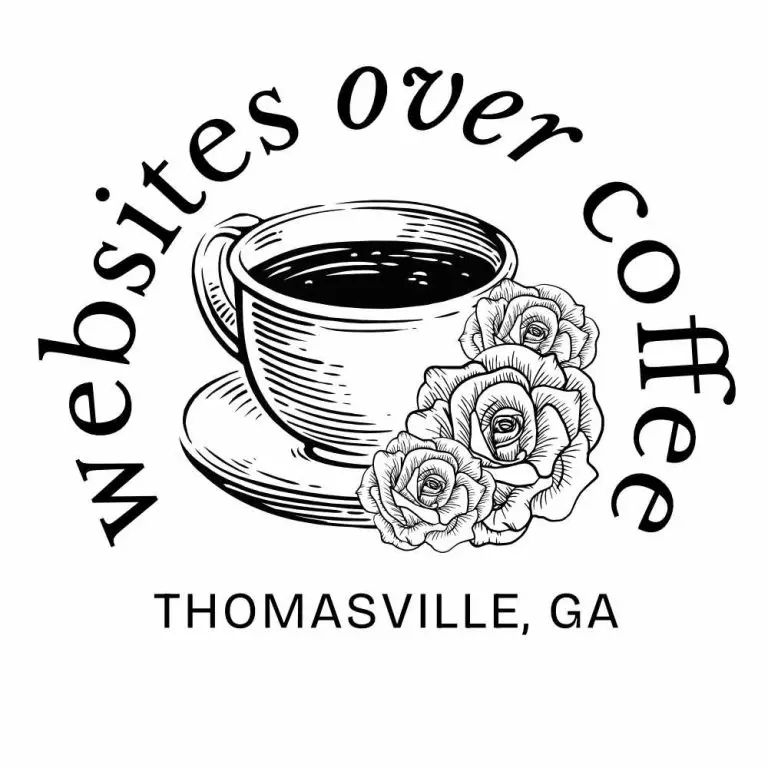The value of white space is one of those things we learn in art school while studying design, and think you are allowed to break those rules. Here’s the thing. Sometimes the most powerful thing you can add to your website is… nothing.
It might feel completely counterintuitive to your entrepreneur heart, but there is power in white space in your design. This doesn’t just include your website. White space in design will elevate your brochures, business cards, PowerPoint slides, and more.
In our desire to share everything we do and serve our audience well, we can accidentally create digital overwhelm that pushes people away instead of drawing them in.
Let’s explore why white space isn’t wasted space. I like to think of it as sacred space that helps your God-given message breathe and be received.
The Overwhelm Epidemic in Our Digital Spaces
To start, I want you to picture two different stores in your mind. The first store is either TJ Maxx or Marshalls. Bonus points if it is around Christmas. No hate on either store, of course. I shop there.
I want you to just pause for a moment and consider how you feel in those spaces.
Now picture some swanky, elite boutique or maybe an Apple Genius bar.
How does that space feel?
Which one makes you feel more peaceful? Which one helps you focus on what matters most?
Your website works the same way. When every pixel is fighting for attention, nothing gets the attention it deserves.
As entrepreneurs, we often struggle with this because we genuinely want to serve our people well. We think more information equals more value. But here’s the truth:
Clarity is the greatest gift you can give your visitors, and white space creates clarity.
What White Space Actually Does (It’s More Powerful Than You Think)
White space isn’t empty space – it’s intentional space. It’s the visual equivalent of a pause in conversation, a rest note in music, or a moment of silence in prayer. It serves several crucial purposes:
White space helps to create focus and hierarchy in your website design.
When everything is competing for attention, nothing wins. White space helps guide your visitor’s eye to what matters most. It’s like having a gentle hand on someone’s shoulder, guiding them toward the most important information.
Adding white space makes it easier for your visitors to process your message.
Our brains can only process so much information at once. White space gives mental breathing room, making it easier for visitors to absorb and act on your message instead of feeling overwhelmed and leaving.
Text surrounded by breathing room is easier to read. Images with space around them have more impact. Buttons with adequate spacing are easier to click, especially on mobile devices.
Clean, spacious design with a good amount of white space communicates that you’re confident in what you offer and sophisticated enough to let your work speak for itself. Just think about the kind of stores that are super cluttered up, vs. the high end experience of a minimalist boutique.
Rest, Space, and Holy Breathing Room
There’s something deeply spiritual about the concept of rest and space. God didn’t create a world where every inch was filled with activity. He created rhythms of work and rest, seasons of growth and dormancy, moments of silence between the notes of creation.
In our recovering productivity junkie journey, I’m constantly learning that more isn’t always better. Sometimes the most loving thing we can do for our visitors is to give them space to process, breathe, and make thoughtful decisions about working with us.
Common White Space Mistakes That Hurt Your Message
Thinking you have to cram everything important into the visible area before someone scrolls. This creates cluttered, overwhelming layouts that actually decrease conversions. Don’t scare your visitors away with anxiety-inducing clutter.
Having a “But I Paid for This Space” Mentality is another struggle many people have, although you see this less with websites.
I used to see this a lot when I designed ads at a Newspaper or when I used to design brochures and flyers. Just because you have a full-width webpage doesn’t mean you need to fill every pixel. Empty space is valuable real estate that makes your content more effective.
When you treat every piece of information as equally crucial, nothing stands out. White space helps create the hierarchy that shows visitors what matters most.

To paraphrase The Incredibles,
When everything is important, nothing is.
Finally, long paragraphs with no breathing room between sections create intimidating blocks of text that many people won’t even attempt to read.
Practical Ways to Add Breathing Room to Your Website
Start with generous margins and padding.
Give your content room to breathe by increasing the space around text blocks, images, and sections. What feels like “too much” space to you probably feels “just right” to your visitors.
Embrace shorter paragraphs. Break up long text blocks into shorter, more digestible chunks. This creates natural white space while making your content more scannable and approachable.
Instead of trying to include everything on one page, spread content across multiple pages. This reduces overwhelm and creates a more focused experience for each page.
Choose quality over quantity.
Feature fewer testimonials, services, or images – but give each one enough space to have real impact. Three well-presented testimonials with breathing room are more effective than ten crammed together.
The Mobile White Space Challenge
White space is even more crucial on mobile devices where screen real estate is limited. What looks spacious on desktop can feel cramped on a phone. Test your site on actual mobile devices and ask yourself:
- Can I easily tap buttons without accidentally hitting something else?
- Is there enough space between other clickable elements?
- Does the text have adequate breathing room to be comfortable to read?
- Do I keep getting lost while reading and scrolling?
- Are images given space to be appreciated rather than just viewed?
How to Audit Your Website for Breathing Room
The Squint Test (Part Two)
We used this for color contrast, but it works for layout too. Squint at your webpage and see what draws your eye. If everything blurs together into a cluttered mass, you need more white space.
The First Impression Check
Ask someone to look at your homepage for 5 seconds, then tell you what they remember. If they can’t identify the most important elements, you likely need more space to create clear hierarchy.
The Mobile Scroll Test
View your site on your phone and scroll through slowly. Does anything feel cramped, overwhelming, or hard to focus on? These are your white space opportunities.
The Content Inventory
List everything on your homepage. Ask yourself: “Is this essential for someone’s first visit?” If not, consider moving it to a dedicated page where it can have proper breathing room.
Questions for Reflection
- Am I trying to serve my visitors by giving them everything, or by giving them clarity?
- How can I create more peaceful, focused experiences in my digital spaces?
- What would it look like to approach web design with the same gentleness I’m learning to bring to other areas of life?
- Where am I allowing anxiety about “missing something” to create overwhelm for others?
The Rhythm of Spacious Design
Just as it’s important to create breathing room in our schedules and priorities, we can create breathing room in our websites. This isn’t about having less to offer. It’s about presenting what we offer with greater clarity and intention.
White space is an act of hospitality. When you give your content room to breathe, you’re telling your visitors: “I care more about your experience than about cramming in more information. I want you to feel peaceful and focused while you’re here.”
Here’s what I’ve learned in my journey from productivity junkie to rhythm embracer: constraint often leads to greater impact. When you’re forced to choose only the most essential elements for each page, you naturally create more focused, effective experiences.
Think of white space as the visual equivalent of sabbath rest. It’s not empty time, it’s restorative time that makes everything else more effective.
Your message is too important to get lost in visual chaos. Your calling deserves a presentation that helps people receive it clearly and peacefully.
Take a few minutes today to look at one page of your website with fresh eyes. Ask yourself: “Does this page feel spacious and focused, or cramped and overwhelming?” Sometimes the most loving thing we can do is remove rather than add.

